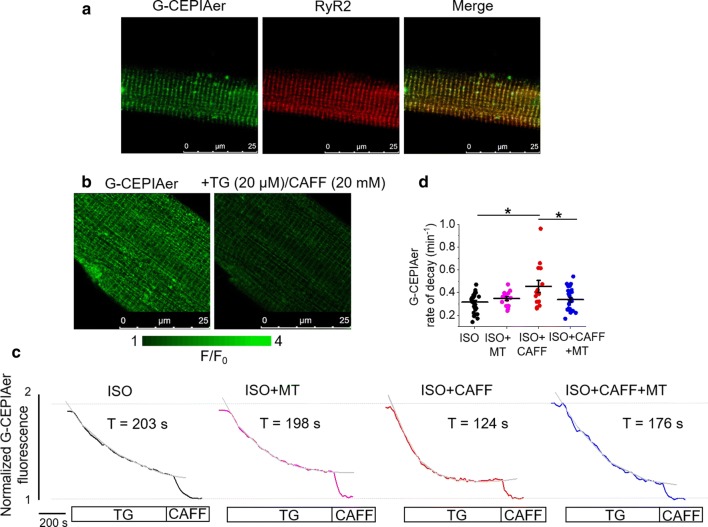Fig.1.
Mitochondrial ROS scavenging reduces caffeine-mediated SR Ca2+ leak in rat VMs. a Representative images of a cultured rat VM 48 h after adenoviral infection with G-CEPIAer intra-SR Ca2+ biosensor (left image, green). Using anti-RyR antibody, VMs were probed for RyR2 expression (center image, red). A merged image is shown on the right, indicating correct probe localization. b Representative images of infected VM treated with thapsigargin (20 µmol/L) and high-dose caffeine (20 mmol/L) to achieve minimal fluorescence, demonstrating G-CEPIAer sensitivity. c Representative time-dependent profiles (F/F0) of G-CEPIAer fluorescence from infected VMs. Myocytes were either treated with ISO (50 nmol/L), ISO and mitoTEMPO (MT, 20 μmol/L, 10 min pretreatment), ISO and caffeine (CAFF, 200 μmol/L), or ISO, CAFF and mitoTEMPO. Myocytes were exposed to SERCA inhibitor thapsigargin (TG, 10 μmol/L) after 1 min of recording, and the time constant of decay (τ, s) was calculated as a measure of SR Ca2+ leak. Signal was normalized to minimum fluorescence obtained by application of high-dose caffeine (10 mmol/L). The graph in d depicts mean data ± SEM for rate of decay (min−1). N = 5–9 animals, n = 14–26 VMs. *p < 0.05 vs. ISO group, **p < 0.05 vs. ISO + CAFF group, one-way ANOVA with Bonferroni post hoc test

